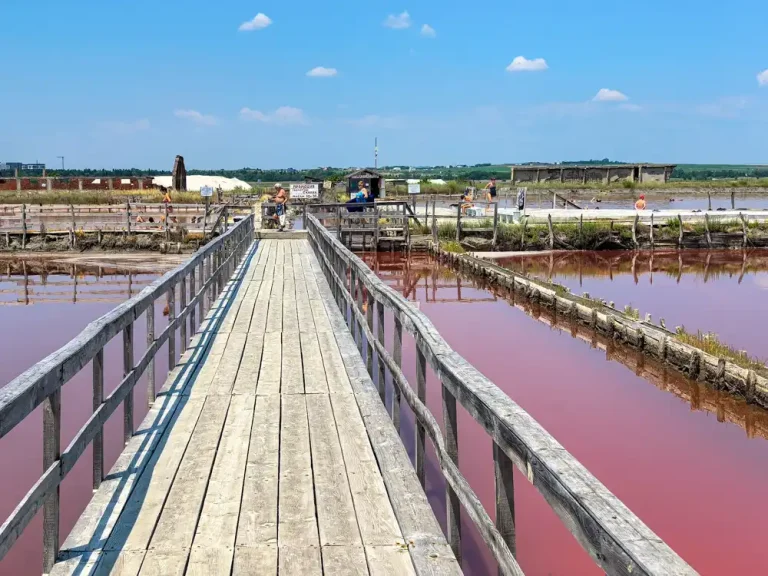The trip to Cabo Girão promised an extraordinary experience. You stand on a glass plate, with a half-kilometre hole below you, and the cliffs and the sea below. But it is nothing unusual in Madeira. After all, even in Calhau das Achadas, near Porto Moniz, you’ll find a cable car, the only way down to the sea. But still. You won’t get to Europe’s highest glass observation deck any time soon.
We set off toward Funchal and Camara de Lobos with a recharged electric car. From here, the cable car (as the only way) also leads down to the Atlantic.
Camara de Lobos
Câmara de Lobos is a small, ultra-photogenic fishing village. In the small harbour, you’ll find lots of colourful boats, dried fish hanging here and there, and a unique atmosphere with locals playing cards here and there. We, however, are drawn upwards.





About a third of the way up the hill, we discover an inconspicuous turn onto a concrete path. Only a few tourists come here. We stop the car and explore one of Madeira’s most enchanting non-commercial trails. “The land here must be worth its weight in gold”, I think, looking at the most incredible building plots. Bizarre building attempts are suspended as in the air.
Wherever can you build? Slovak developers still have fabulous reserves in their imagination. We are treated to the sight of the incredible building feats below us and the opposite hills, entirely built up to the last square metre. Where there is no concrete, there is a garden.
Another trail runs parallel to the track (about 50 m below see map). It is marked Levada do Facho. We did not find the water stream at first. But it is there. It runs partly under the trail. Holt. In Madeira, when inhabiting the hills, it is the access to water that is crucial.
Levada do Facho




Note: Levada is the name of an irrigation canal in Madeira. The existence of levadas is due to the island’s geological structure, which is actually the top of an ancient volcano. The geological layers of lava, ash and tuff are not horizontal, but the predominant inclination is north. Hence, the rain that soaks in on the southern slope flows northwards beneath the surface. Some of the springs are located at heights of up to 1600 m. The most intense rainfall occurs around 1000 m above sea level, where most levadas begin. The Portuguese have, therefore, started to build canals to carry water from the north to the south.
The good thing about many levadas is that they test your balance and ability to walk up the most incredible slopes without belaying. When crossing the Levada Nova, Peter decided to walk in a trough full of water rather than on the trail. On Cabo Girao, we rather appreciated the building efforts of the locals. Where the tourists hardly walk, they are concreting, building, planting tomatoes, flowers and herding goats. Walking that trail impressed us more than the glass vista itself.
Cabo Girão



You’ll know who the glass terrace is for as soon as you park. The show must go on. Turnstiles, booths, vendors, total commerce. Then, a short walk, maybe two hundred yards, and you’re standing on that glass slab. When I stood on the patio’s edge, my ass was a little tight. If you have a problem with stability, you’d better not look under your feet. After all, half a kilometre is not a short distance. But I got used to it very quickly. The views from the terrace are amazing.
When you’re standing on the glass





Cape Girão in Madeira is one of the most famous tourist spots, and for good reason: it is one of the highest cliffs in Europe at 580 metres. When you get there, you get an impressive panoramic view of the Atlantic Ocean and the island’s southern coast, as well as of the Câmara de Lobos and Funchal.
The terrace was opened in 2012, and it is an excellent source of income for the whole island.
Capela de Nossa Senhora de Fátima





Cabo Girão is safe, and it won’t take you more than half an hour to cross it (as long as you don’t jump off the terrace). Therefore, if you still hike up about a kilometre after the viewpoint, you’ll discover a large car park with a small church and the most beautiful views of the surrounding Madeira hills without telegraph and electric wires. Their development reminded me of the rice paddies of Bali.
Camara de Lobos, Levada do Facho and Cago Girao: it’s a beautiful and colourful day in Madeira out not far from Funchal and close to the centre of Madeira’s digital nomads, the port and beach town of Porta del Sol.




